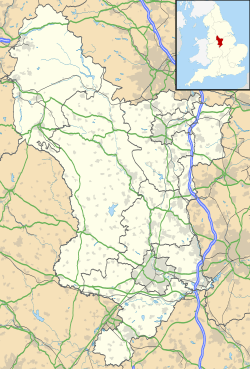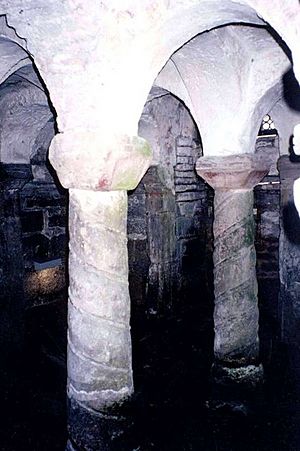Repton Abbey facts for kids
| Monastery information | |
|---|---|
| Order | Benedictine |
| Established | c. 600 |
| Disestablished | Abandoned 873 |
| People | |
| Important associated figures |
|
| Site | |
| Location | Repton, Derbyshire, England |
| Coordinates | 52°50′29″N 1°33′04″W / 52.841308°N 1.55102°W |
Repton Abbey was an important old abbey in Derbyshire, England. It was built during the Anglo-Saxon period, around the 7th century. This abbey was special because it was a double monastery. This means it was home to both monks and nuns living in separate areas.
Repton Abbey was famous for its connections to many saints and powerful Mercian kings. Two kings of Mercia were even buried in the abbey's special underground room, called a crypt. The abbey was left empty in the year 873. This happened when a large group of Viking warriors, known as the Great Heathen Army, took over the area.
Contents
Repton Abbey's History
People traditionally say that Saint David started the abbey around 600 AD. However, some records suggest it might have been founded about 60 years later. It could have been started by the royal family of Mercia.
The abbey was a unique place that housed both monks and nuns. An abbess was in charge of the whole community. The first recorded abbess was Saint Werburgh (who died in 699 AD). She was the daughter of King Wulfhere of Mercia. Most of the monks and nuns at Repton Abbey were from noble or royal families. Many abbesses, like Werburgh, were related to kings and queens.
In 697 AD, a man named Guthlac visited the abbey. At that time, Abbess Alfthritha was in charge. Guthlac came to the abbey to become a monk and show he was sorry for his past actions. He later left the abbey to live a quiet life alone as a hermit.
The Abbey's Crypt
The abbey's crypt was built in the early 8th century, before 740 AD. It is believed to have been a baptistery at first, a place for baptisms. This is because it was built over a natural spring. Later, it was changed into a mausoleum, which is a building for burying important people.
The first person buried there was King Æthelbald of Mercia. He died in 757 AD. King Wiglaf of Mercia later improved the abbey church's east end and the crypt. King Wiglaf was buried in the crypt after he died in 839 AD.
King Wiglaf's grandson, Wigstan, became king after him. King Wigstan was killed in 840 AD. His body was also placed in the crypt in 849 AD. People started reporting amazing things happening at his tomb. Because of this, the abbey became a popular place for pilgrimages. From the 9th century, Wigstan was seen as a saint. Many visitors came, so extra staircases were built to help people go in and out of the crypt.
Around the 9th century, covered walkways called porticoes were added to the north and south sides of the abbey church. The church itself was decorated with colorful stained glass, stone carvings, and stucco wall designs.
The Abbey's Destruction
In the autumn of 873 AD, the Great Heathen Army arrived in Repton. They set up their winter camp there. In 874 AD, they finished taking over Mercia. The monks and nuns at Repton Abbey had to leave quickly. They took the remains of Saint Wigstan with them.
The Viking army robbed and destroyed the abbey. They built a strong camp in the abbey grounds, between the church and the River Trent. The River Trent used to flow right next to the abbey. Now, it is about a quarter of a mile north of the village.
In the area where the current vicarage's lawn is, archaeologists found a Viking burial mound. Inside it, they found the remains of 200 Viking men and 49 Anglo-Saxon women. Other Viking burial mounds are at the nearby Heath Wood barrow cemetery.
When the Vikings left in 874 AD, they had destroyed the abbey buildings. Many of these buildings were made of wood. They also set fire to the abbey church.
Repton's Parish Church
For more recent history, see: St Wystan's Church, Repton
The abbey church was partly repaired about 40 to 50 years later. It then became a parish church instead of an abbey. Not much of the original Saxon abbey church could be saved. Most of the upper walls and the entire roof had to be completely rebuilt.
In the 12th century, the right to choose the church's priest was given to the new Repton Priory. This priory was built a short distance away. The church was rebuilt and made larger between the 13th and 15th centuries. The tall, 212-foot tower and spire were added in the 15th century.
The Abbey's Crypt and Burials
The abbey's crypt was built over a spring in the early 8th century. It was likely used for baptisms at first. Later in the 8th century, it became a burial place for important people. King Æthelbald of Mercia (who ruled from 716 to 757 AD) was buried there. King Wiglaf (who died around 840 AD) and his grandson Saint Wigstan (who died in 840 AD) were also buried in the crypt. It is thought that these royal bodies were first buried in the ground. After they had decomposed, their bones were placed inside the crypt.
After people reported miracles linked to Saint Wigstan, the crypt became a place where many pilgrims visited. However, after the Viking invasion, Wigstan's bones were taken away by the monks and nuns who fled. They were later brought back. But King Cnut had Wigstan's remains moved again in the 10th century. They were reburied at Evesham Abbey.
The crypt became part of the later St Wystan's Church, Repton. This church was built where the abbey used to be. Nikolaus Pevsner, a famous expert on buildings, said that the Anglo-Saxon parts of this church are "one of the most precious survivals of Anglo-Saxon architecture in England." Besides the crypt, these parts include the chancel, parts of the crossing, and part of the north transept. The crypt is a square room with a roof made of three rows of three domed sections. These are held up by pillars on each wall and four pillars in the middle.
Royal Burials at Repton
- Merewalh, a local king (died between 670 and 685 AD)
- King Æthelbald of Mercia – died in 757 AD.
- King Wiglaf of Mercia – died in 839 AD.
- Prince/Saint Wigstan – died in 849 AD. (His remains were later moved by King Cnut to Evesham Abbey.)
Viking Burial Site
In the 1980s, archaeologists Martin Biddle and Birthe Kjølbye-Biddle found a large burial site at St Wystan's Church in Repton. It was believed to be connected to the Great Heathen Army. This site contained about 300 human skeletons. About one-fifth of them were women. The other 80% were men, aged 18 to 45. Many of the skeletons showed signs of injuries from fighting. Various Viking items, like a Thor pendant, were found among the bones.
At first, radiocarbon dating suggested the bodies had been buried over several centuries. However, in February 2018, a team from the University of Bristol announced new findings. They showed that all the remains could indeed be from the late 800s AD. This matches the time the Viking army stayed in Derbyshire. The first dating results were different because the Vikings ate a lot of seafood. Carbon from the ocean is older than carbon from land. This difference is called the marine reservoir effect, and it needs to be adjusted for accurate dating.
Abbesses of Repton
- Saint Werburgh (died 699 AD) is recorded as the first known Abbess of Repton. She was the daughter of King Wulfhere of Mercia.
- Saint Edburga of Repton (died around 700 AD) is thought to have been the daughter of King Ealdwulf of East Anglia. She became abbess with the support of Wulfhere, King of Mercia. She is honored as a saint. She took over as Abbess of Repton after Elfrida died. Saint Edburga is mentioned in the story of Saint Guthlac. Her remains were later moved to Southwell. A guide from 1000 AD mentions that "There resteth Saint Eadburh, in the minster of Southwell, near the water of the Trent."





